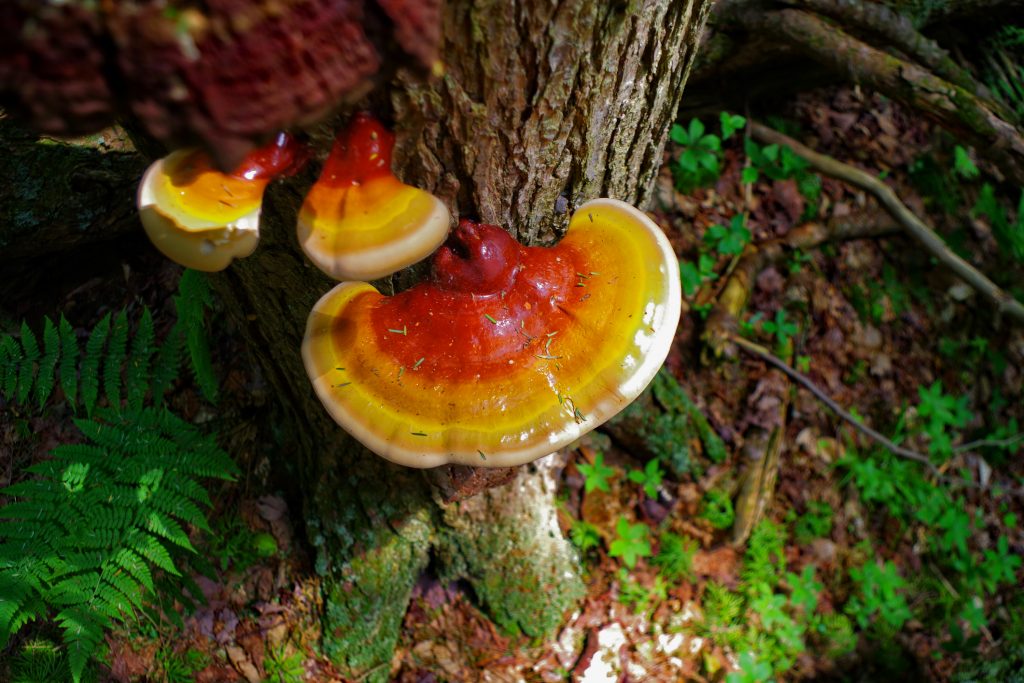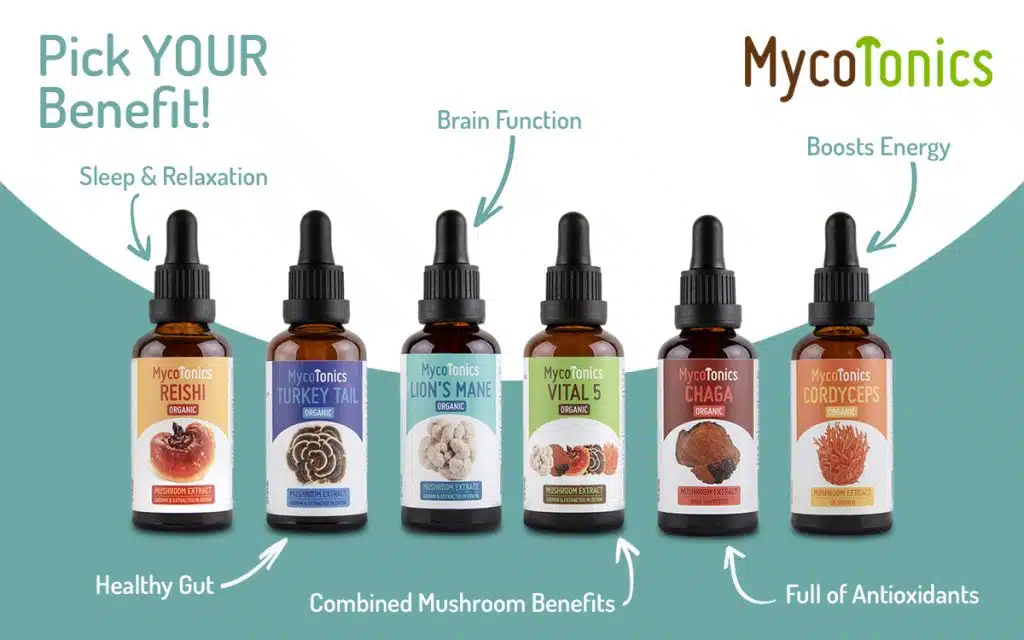Reishi mushrooms are one of the most potent medicinal mushrooms that have been discovered. They’ve been used for a variety of purposes for thousands of years and are referred to as the “king of mushrooms” in traditional Chinese medicine.
The health benefits of reishi mushrooms are immense. The problem is that you can’t simply add reishi to a dinner recipe like a shiitake or oyster mushroom. Reishi mushrooms are very tough and woody and need to be prepared in a specific way.
If you’re in the UK I’d love for you to have a look at our range of extracts which includes reishi.
Luckily it’s not that difficult to use reishi. In this article we’re going to explain how you can get medicinal benefits from reishi mushrooms. You’ll also learn what reishi mushrooms look like, how to choose the best reishi mushrooms, where to purchase them and much more.
But first, let’s cover some of the basics of this medicinal mushroom.
What Are Reishi Mushrooms?
Reishi or Ganoderma mushrooms go by many different names. In Asia they’re known by the names lingzhi, ten thousand year mushrooms and the mushroom of immortality. In North America they’re known as varnish shelf mushrooms, artist’s conk or bear bread.
There are about 80 different species of reishi mushrooms in the world. All are shelf or bracket fungi that grow on trees. Different regions and climates will have different types of reishi mushrooms that look a bit different.
However their medicinal properties are mostly all the same. Some scientists even think there’s only a few species that take on a different appearance depending on their habitat or the type of tree that they’re growing on.
All reishi species grow on trees that are dead or dying. The mushrooms will continue growing every year until the wood has completely rotted away. You can come back to harvest them again and again.
What Do Reishi Mushrooms Look Like?
Reishi can be one of the easiest mushrooms to identify because they often have quite a unique appearance. If you see a shelf mushroom with a deep red body and colors that lighten to orange, yellow and white toward the edges of the cap, you can be confident that you’re looking at a reishi mushroom.
Reishi mushrooms are a type of shelf mushroom that you can find growing horizontally out of the trunks of trees. They don’t have any noticeable stem like mushrooms that grow out of the ground.
Older specimens may fade to a brown color and be harder to identify. However their scallop-shaped cap with tree-like rings on the top is a pretty good indication.
There aren’t any poisonous mushrooms that look similar to reishi mushrooms, so they’re good for even beginners to try and collect. The worst-case scenario is that you’ll end up with a similar-looking mushroom that offers a lot of extra fiber to your diet but no real medicinal benefits.
Are you interested in growing mushrooms for a living? Our article How To Set Up A Low Tech Mushroom Farm explains how to get started.
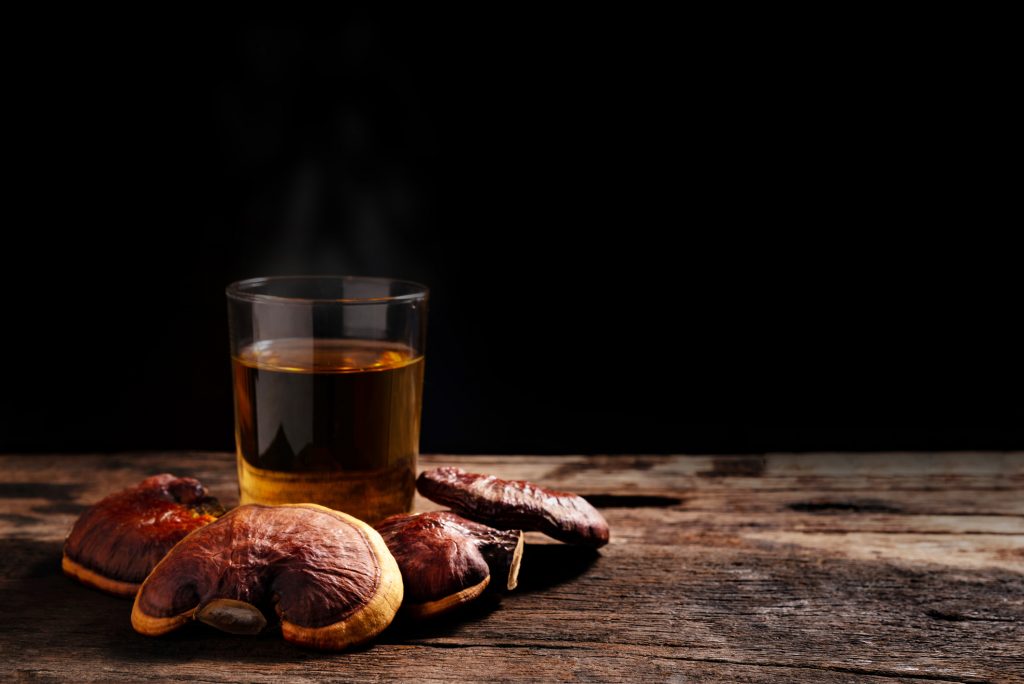
How to Cook With Reishi Mushrooms
While they’re technically edible, all but the youngest reishi mushrooms are going to be far too woody and tough to eat on their own. Even if you diced them up very finely and cooked them, it will taste like you’re eating a cork.
Mature reishi mushrooms have a hard outer shell that makes them completely inedible.
How to Prepare Reishi Mushroom
You could try adding dried reishi powder to smoothies or sprinkling it into recipes for some of the medicinal benefits. However the traditional way to consume reishi is to make it into a tea.
This isn’t the convenient bag of tea that you’re used to steeping for just a minute or two. Fresh reishi mushrooms will need to be boiled for half an hour to extract all of the medicinal compounds. Dried reishi will need to be boiled for at least an hour or two.
The mushroom needs to be thinly sliced for best extraction of the medicinal properties.
Once you’ve made your reishi tea, you’ll find that it’s very bitter. It’s not really something you can sit down and enjoy for the taste.
This is probably why the go-to method of consuming reishi mushrooms is to take the dried powder in capsule form. That way you don’t have to put yourself through the time-intensive process of making it into a tea, nor deal with the bitter taste of actually drinking it.
You can also find reishi in some powdered mixes that you can sprinkle on food or in coffee.
For more mushroom recipes, check out 30 of our favorite mushroom recipe ideas.
Reishi Mushroom Health Benefits
What is reishi mushroom good for? Maybe you’ve heard friends or family members talk about the fungi, but aren’t exactly sure what its use is.
There are an endless number of medicinal claims that have been made about reishi mushroom benefits. Some have been well-studied and proven, while others currently lack any scientific evidence to support them.
The lab studies so far have identified some interesting compounds in reishi mushrooms.
Beta-glucans – These compounds may be able to help stop the spread and growth of cancer cells. In animal testing, animals fed beta-glucans had more active and stronger immune systems.
Triterpenes – These substances have anti-allergy and blood pressure lowering effects.
Sterols – Act as precursors to human hormones in the body.
Reishi mushrooms have been shown to slow blood clotting. One study also suggests that reishi extracts can help with urinary tract problems.
One study even suggests that the reishi mushroom may be helpful in lowering cholesterol. Although so far this has only been tested on animals.
Untested claims of the reishi mushroom include potential uses in treating HIV and AIDS, fatigue and other medical conditions.
Reishi mushrooms are considered an adaptogen, which is a plant or fungi that can help the body resist or cope with physical and mental stress.
Lastly, reishi may be used to treat diabetes and insulin resistance.
More scientific studies need to be completed before we can say definitively what the benefits of this mushroom are. However preliminary research suggests it likely has anti-inflammatory, antiviral, antibacterial, antioxidant and analgesic (pain-relieving) properties.
You can learn more about the health benefits of mushrooms here.

Reishi Mushroom Dosage
Reishi mushroom dosage may vary depending on what product you’re using and how it’s being consumed.
If you’re taking a reishi extract, you’ll need to refer to the manufacturer’s recommendations. Extracts can be made at different strengths, for example a 4:1 or 10:1 ratio. Dosage will depend on how strong the extract is.
If you’re taking a dried reishi powder, a good generally accepted dosage is 1,000 mg once or twice per day.
Reishi Mushroom Potential Side-Effects
While reishi mushrooms are generally considered safe, there are a few known cases of side-effects and complications.
In rare cases, reishi may cause liver toxicity. So it should be avoided by people with conditions affecting the liver like cirrhosis or hepatitis. In healthy subjects, a study of taking reishi mushroom extract for four weeks didn’t show any negative effects on the liver or kidneys.
There have not been any studies done on the effects of reishi on pregnant or breastfeeding women. So as with many other types of medication, it’s best to avoid consuming reishi mushrooms if you’re pregnant, trying to conceive, or breastfeeding just to be safe.
Since reishi can lower blood pressure, it’s best to avoid it if you already suffer from low blood pressure. Likewise, if you are currently taking medication for high blood pressure it may interact with it and lower your blood pressure to dangerous levels.
Consuming reishi also increases the risk of bleeding, so it’s best to avoid it if you suffer from hemophilia or other bleeding disorders. Be aware that even common medications like aspirin or ibuprofen can slow blood clotting, so avoid combining them with reishi.
For the same reason, it should also be avoided before undergoing surgery. If you’re currently taking reishi, you should stop using it at least two weeks before your scheduled surgery date.
For the average person without any pre-existing medical conditions who isn’t currently taking any medications, the side effects of taking reishi mushrooms are minor. The most common side effect reported is an increased risk of upset stomach.
Can Reishi Mushrooms Cure Cancer?
It is true that studies on the use of reishi for cancer treatment have been done and some show promising results. However this research is fairly new and hasn’t been widely replicated yet, so it’s difficult to draw definite conclusions from it.
Preliminary research suggests that reishi helps to improve the response of lung cancer tumors to conventional therapy. However it’s hard to know if we can extrapolate this to say that it would be helpful for other types of cancer.
Also, no studies to date recommend the use of reishi mushrooms as a standalone treatment. Instead it is used in addition to conventional medical methods to further enhance them.
If you are currently undergoing chemotherapy or radiotherapy, then it may be worth discussing with your physician if it’s worth adding reishi to your treatment regiment. Learn more about medicinal mushroom extracts here.
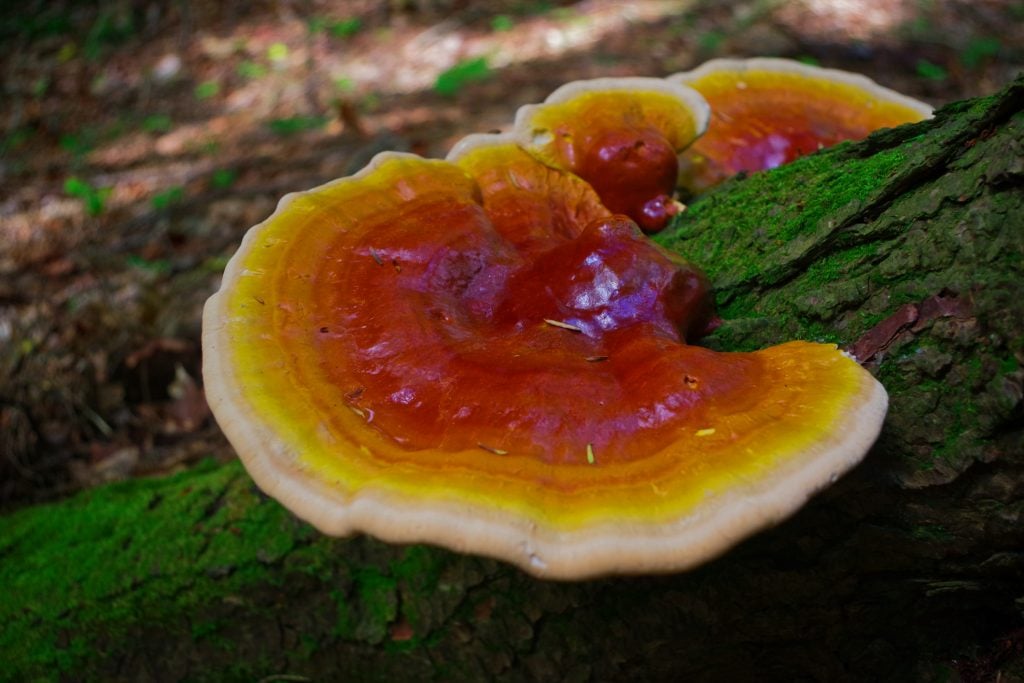
Harvesting Reishi Mushrooms
Collecting your own reishi mushrooms is simple and straightforward.
We recommend looking at the underside of your reishi mushrooms before harvesting them. A mushroom that is white underneath is young and will contain the most medicinal compounds. Older reishi mushrooms can be harvested but they will be tougher and more bitter.
Older reishi may also potentially harbor harmful mold.
To harvest a reishi mushroom, simply pull it off the tree. Using a slight twisting motion can help to loosen it. For younger and softer mushrooms, a knife can be used to cut them off the tree.
How To Clean Reishi Mushrooms
If you’re harvesting wild reishi mushrooms, cleaning them is fairly simple. Start by doing a visual check to make sure there are no insects or worms present. (Mature reishi mushrooms have a very hard outer shell. That makes them a lot less likely to have problems with pests or to get dirty compared to many other types of mushrooms.)
Then, simply scrub them with a toothbrush or other stiff brush to get the majority of the dirt off.
For reishi mushrooms with lots of dirt or other impurities, you can wipe them down with a damp cloth to remove any excess dirt. Avoid submerging them in water as they can absorb the liquid, which makes them more prone to mold or spoiling.
How To Store Reishi Mushrooms
As with all other varieties of mushrooms, even hard and woody reishi mushrooms will quickly spoil if not preserved after harvesting. So unless you plan to use them right away, you’ll want to preserve them by drying them out.
Cutting your reishi mushrooms into thin strips or small pieces will help them to dry out faster. Whole mushrooms can be too thick to properly dry the whole way through. Plus they will be more difficult to cut into smaller pieces once they do dry.
Looking for other ways to store your reishi? Read about freezing mushrooms.
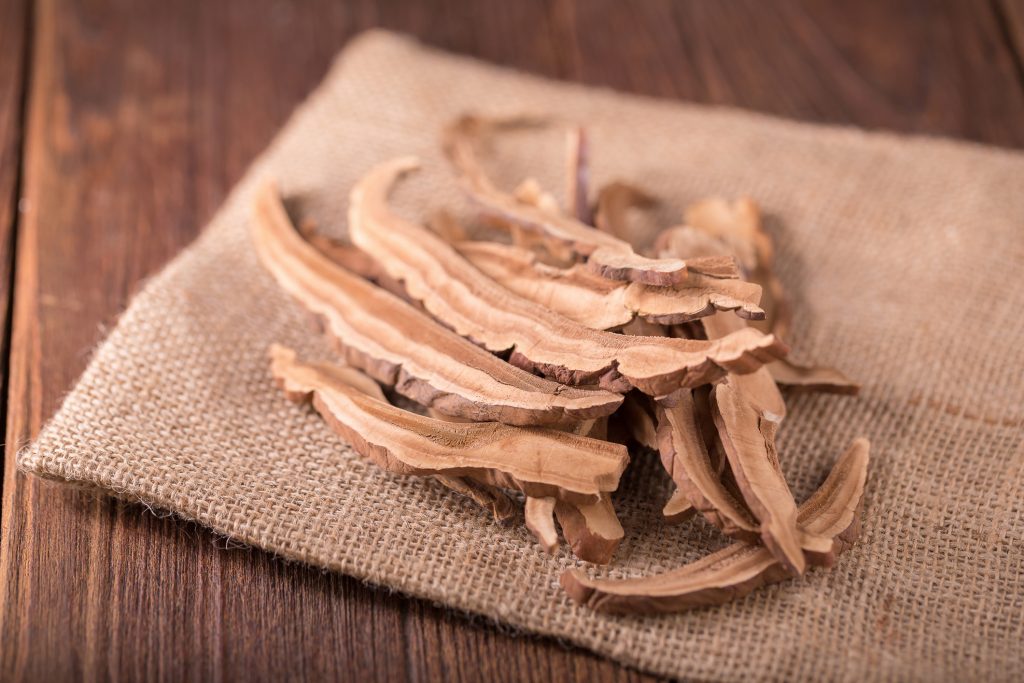
How To Dry Reishi Mushrooms
Reishi mushrooms can be left out in the sun to dry. If you have a food dehydrator, that will provide the quickest and most uniform drying. Using an oven on the lowest temperature can also dry them out if you don’t want to wait for them to dry naturally.
Once your reishi mushrooms have been dried, you should store them in an airtight container in a cool, dark place. Dried reishi mushrooms will last for a year or more. To even further extend their shelf life, you can add a desiccant or oxygen absorber to the container to absorb any residual moisture.
As an alternative to drying, reishi can also be made into a tincture. If you’re making a tincture, you can use fresh reishi mushrooms and no drying is needed. Simply chop them into small pieces.
Some of the medicinal compounds in reishi mushrooms are water-soluble and others are alcohol soluble. To get the maximum benefit, we recommend a double extraction tincture.
To make a mushroom double extraction, start by putting your reishi mushrooms in a jar filled with alcohol for a month, shaking daily. The alcohol content should be somewhere between 25% and 30% to keep your tincture shelf-stable.
After a month, strain the mushrooms and set the mushroom-infused alcohol aside. Bring a pot of water to a boil and add the mushrooms from your extract to the water. Let them simmer for about two hours until the water has mostly reduced down.
Let it cool down and then you can strain the mushrooms out.
Combine your water extract and alcohol extract and your tincture is complete! Just a few drops of this concentrated liquid per day is enough to take advantage of the medicinal benefits of reishi mushrooms.
Common Reishi Mushroom Species or Types
Many mushrooms in the Ganoderma family may be referred to as reishi mushrooms. Some scientists believe that a single reishi mushroom may have evolved and adapted to different climates and habitats, while others believe they are distinct species.
Technically speaking, the official species of reishi is Ganoderma lingzhi. This is the traditional lingzhi mushroom used in traditional Chinese medicine.
Ganoderma lucidum is another very similar species that is also used in Chinese medicine. It is used almost interchangeably with G. Lingzhi. However it’s more widespread and besides growing in Asia, it can be found in Europe and the Southern United States.
It prefers to grow on oaks and other hardwood trees.
Ganoderma tsugae is a reishi species that’s more commonly found in the Northeastern United States. The Japanese name tsugae refers to the hemlock tree. While this species of reishi can be found on maple or birch trees, it’s most commonly found on hemlock and other coniferous trees.
Ganoderma curtisii is one of the most widespread reishi mushrooms in North America. It can be found from Nebraska to Massachusetts. As with the other species mentioned above, you can identify it by its vibrant cap that shifts from red in the middle to orange, yellow and white on the outer edges.
Unlike other reishi mushrooms it tends to have more of a matte finish instead of a shiny look.
Ganoderma oregonese is a species of reishi that grows on coniferous trees in the pacific northwest of the United States. These are some of the largest reishi mushrooms and can grow to three feet (one meter) across.
Ganoderma sessile mushrooms are found on oak, maple and other hardwood trees. Unlike most other types of reishi, the caps of these mushrooms are quite bendable and soft.
Ganoderma applantum is the opposite of G. Sessile as it’s a very woody and hard variety. Its color also tends to be more brown and dull compared to other kinds of reishi mushrooms. It’s often so hard and dry that you’ll need to use a saw to cut it.
There are many other reishi species like Ganoderma capense, Ganoderma resinaceum and Ganoderma carnosum.
Reishi Mushroom Lookalikes
Since all reishi mushrooms generally look the same and have similar medicinal benefits, there isn’t any significant benefit to finding out which specific type of reishi mushroom you have. As long as you can tell that it’s a reishi mushroom, that’s good enough.
Unless you are studying them for academic purposes, you can use all reishis for their medicinal benefits.
Still, you’ll want to avoid other fungi that happen to look like reishi mushrooms. While there aren’t any poisonous look-alikes to worry about when searching for reishi, you don’t want to go through the effort of collecting and drying non-medicinal mushrooms that don’t offer the medicinal benefit.
The most common reishi mushroom to watch for is the red belted conk (Fomitopsis pinicola.) It can look a lot like a reishi since it grows out in rings with a red color in the center that lightens to a white color around the edges.
You can distinguish reishi from the red belted conk by scratching the underside. A reishi mushroom will bruise underneath if the pore side is scratched, whereas a red belted conk will not.
You can also do a spore print to distinguish between them if you’re still unsure. A red belted conk has a white or yellowish spore print, while a reishi mushroom will leave a dark brown spore print.
It’s worth noting that the red belted conk also has medicinal qualities and has been traditionally used by Native Americans. So even if you accidentally harvest and consume one, it will still offer some benefit.
To the untrained eye, reishi mushrooms may also be difficult to tell apart from other bracket or polypore mushrooms that grow on the side of trees. The section below should help to properly identify reishi mushrooms.
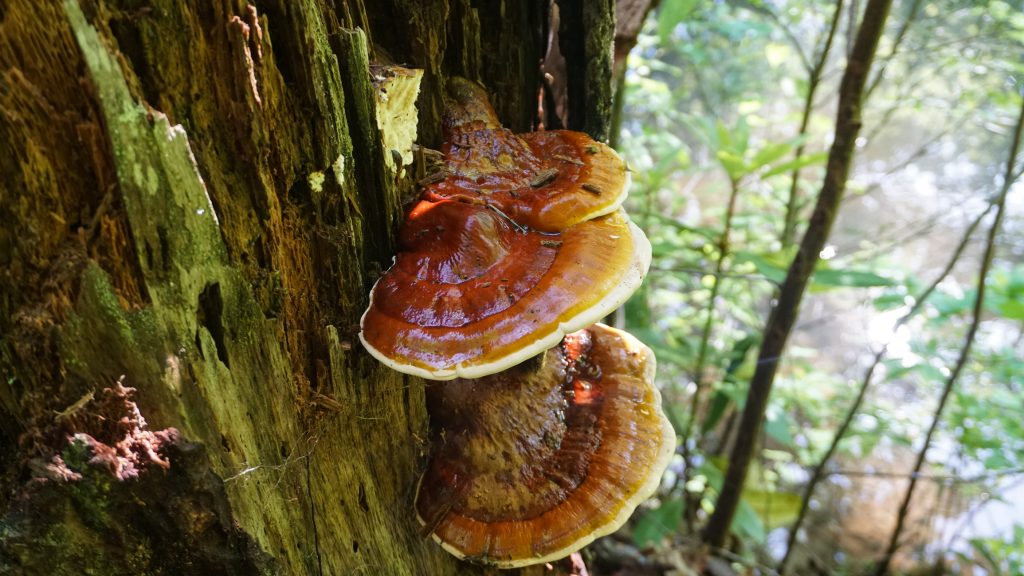
How To Identify Reishi Mushrooms
Reishi mushrooms are saprotrophic, which means that they get their nutrients from dead or organic matter. You will mostly find them on dead or dying trees. Particularly old logs or stumps.
If you find a shelf mushroom growing on a healthy young tree, it’s not likely to be a reishi mushroom.
Reishi mushrooms prefer to grow on hardwood trees like oak, elm, beech and maple. However some species we discussed above can prefer conifers, particularly hemlock.
Reishi mushrooms are most in season from the summer to fall, although you may find older mushrooms still on trees year-round.
Reishi Mushroom Appearance
The cap of a reishi mushroom is fan or kidney-shaped. It will have a reddish cap and may have varying shades of orange, yellow and white toward the outer edge.
Young reishi mushrooms will have a wet and shiny look to them, almost like a varnish or lacquer has been applied to them. As they age, the cap tends to become more dull looking.
Most varieties of reishi rarely get more than an inch or 2/ 2 to 5 centimeters in thickness or more than a foot or 1/3rd of a meter across.
Spore print will be a dark brown color. Reishi mushrooms may or may not be attached to trees by a stem.
Where Reishi Mushrooms Grow and How To Find Them
Different types of reishi mushrooms can be found all over the world. They have been found in Asia, North and South America, Australia and Southern parts of Europe.
Some reishi species prefer a more tropical climate, while others like colder temperatures. So you may be able to find some variant of this mushroom almost anywhere.
To find reishi mushrooms, look toward the bottom few feet of dead or dying trees. They tend to grow closer to the ground. So any large shelf mushrooms that you find at head height or above are unlikely to be reishi mushrooms.
Between May and July is the best time to get out and look for fresh reishi mushrooms. You’ll have the best luck in a hardwood forest. But since they can also grow on coniferous trees, our recommendation is just to get out and look at every dead or dying tree that you pass.
Since reishi grow at the base of trees, be sure to watch out for poison ivy or other toxic plants that may be growing around them.
Reishi mushrooms are a wood-loving variety. Much of what we explain in our article How To Grow Shiitake Mushrooms: The Ultimate Guide will also apply to growing reishi.
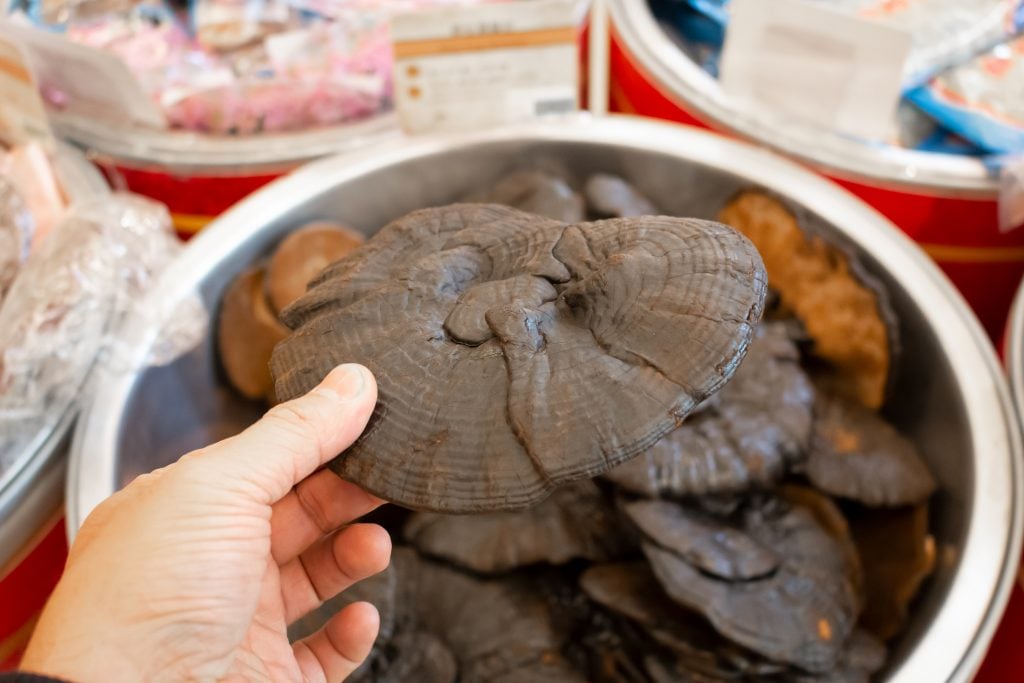
Where to Purchase Reishi Mushrooms
You won’t find reishi mushrooms in most grocery stores. Some health stores or pharmacies may carry reishi in a dried powder or capsule form. However your best bet is to order online from a reputable seller in your country.
There are a variety of options, including buying whole mushrooms online if you want to grind them up yourself.
How to Choose The Best Reishi
When buying reishi products, be sure to read the label to see what you’re getting and only buy from reputable sellers. Some low-quality reishi products may only contain reishi mycelium or grains, which is basically the waste byproduct of growing the actual mushrooms.
You want to buy reishi supplements that contain actual fruiting bodies, or the stems and caps of the mushroom.
Independent studies have shown that only 26.3% of reishi products tested actually contain what’s listed on the label. Unfortunately the study does not disclose which brands are and aren’t accurately reporting what’s in their products.
But it does make it even more important to ensure that you’re getting a top-quality reishi product from a trusted seller.
Japanese red reishi is generally regarded to be one of the highest quality forms of reishi that you can buy.
See our article Medicinal Mushroom Extracts and Supplements: A Buyers Guide for additional guidelines on what to look for.
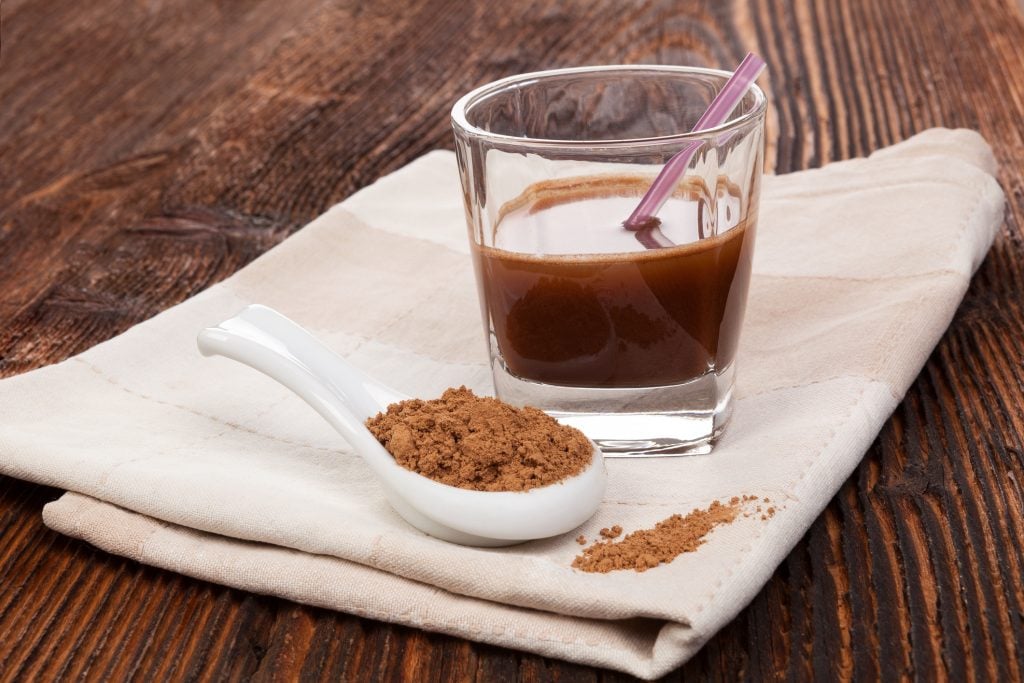
What Does Reishi Taste Like?
Reishi is definitely not something that you eat for the enjoyable taste. It is consumed entirely for its medicinal benefits.
Many of the compounds in reishi that have medicinal benefits are triterpenes. These are compounds that plants and fungi produce specifically to stop animals from eating them.
Some people say that reishi has a very bitter taste. Others liken it to eating tree bark. The bottom line is that it’s not an enjoyable culinary experience.
Adding some honey or another sweetener can help make the experience better. Personally, we recommend adding it to a smoothie to help mask the taste.
History of Reishi and Fun Facts
In traditional Chinese medicine, reishi has several interesting names. It’s referred to as the mushroom of immortality, the king of mushrooms, the soul mushroom, divine mushroom and many other titles.
That should give you some idea of the importance of this fungi. It has been used medicinally for over 2,000 years. Doctors across Asia still prescribe reishi mushrooms to treat a variety of health conditions.
In nature, reishi mushrooms are quite rare. It’s said that only two or three out of 10,000 hardwood trees will have reishi mushrooms growing on them. The good news is that it can be cultivated on blocks of sawdust and other substrates.
How to Grow Reishi at Home
Reishi mushrooms can be a great pick for the home mushroom grower. While they aren’t quite as prolific and easy to grow as oyster mushrooms, they’re still one of the easier species to start with. Reishi mushrooms are strong colonizers and are quite resistant to contamination.
For beginner growers, we recommend buying a reishi mushroom grow kit. That way you’ll receive a fully colonized bag of reishi mycelium. All that you need to do is cut the top off the bag to expose it to air and regularly mist the bag to keep it moist.
You will start to see reddish-brown “antlers” start to form that will eventually grow into full-sized reishi mushrooms.
If you’re growing from a kit, it will take about six weeks before your reishi mushrooms are ready to harvest.
For more advanced mushroom growers, you can buy sawdust spawn, or even buy plug spawn and use it to inoculate your own logs.
Since mycelium is a living thing, we recommend ordering mushroom kits from a local company in your country that’s as close to you as possible. That way you’ll minimize shipping time and how much the package is getting tossed around.
Your seller should provide you with a set of instructions for exactly how to take care of their kit and generate the best possible results. The process is generally pretty similar to most other varieties of mushrooms, though.
Reishi likes high levels of humidity (75 – 85% relative humidity,) low levels of light and fresh airflow to fruit.
Our article, “How to Grow Reishi Mushrooms: The Ultimate Guide” has more information and step-by-step guides to get you started.
Final Thoughts
Reishi mushrooms aren’t very tasty. Their hard woody caps aren’t good for adding to recipes, but this mushroom is still one of the most sought-after for its medicinal benefits.
While more studies need to be done before we can say for sure, reishi mushrooms show promising results for people with cancer, high blood pressure, diabetes and other medical conditions.
You can find reishi mushrooms growing on the sides of dead or dying trees all around the world. These shelf mushrooms have a distinctive reddish appearance and may also feature varying shades of orange, yellow and white.
Reishi mushroom can also be purchased as a powder, extract or tincture. Be sure to purchase from a reputable seller to ensure you’re getting a high-quality product.
If you’re interested in mushrooms for their health benefits, we feel that reishi is a variety that should be at the top of your list and one of the healthiest mushrooms to eat.
Had fun reading all about reishi? We recommend checking out our guides to porcini or puffball mushrooms next.
